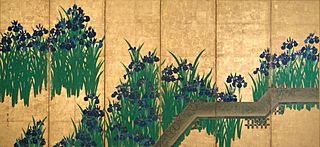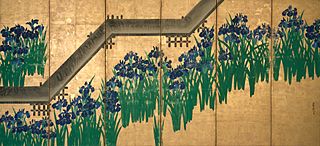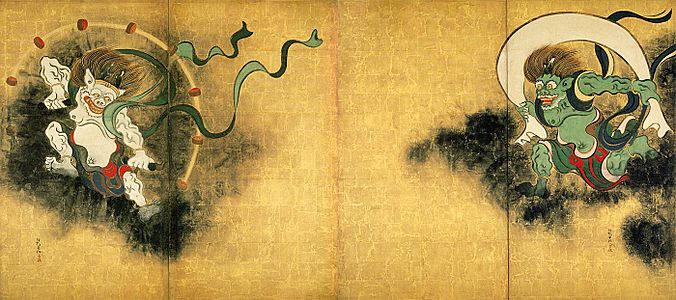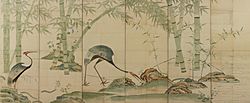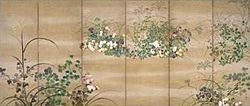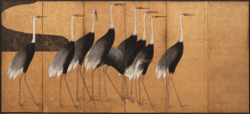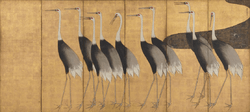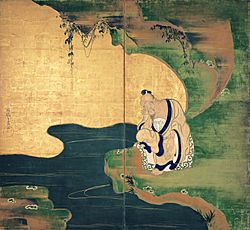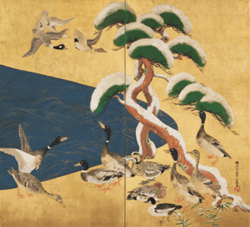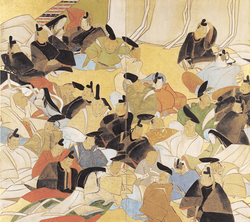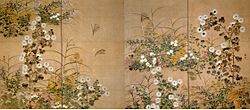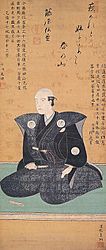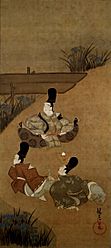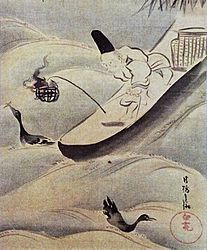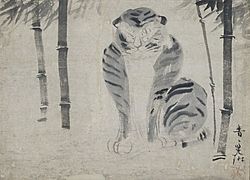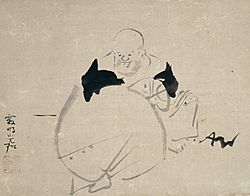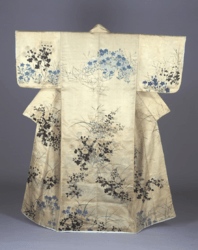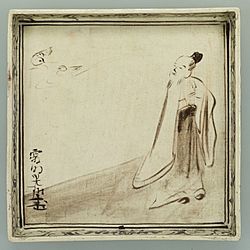Ogata Kōrin facts for kids
Quick facts for kids
Ogata Kōrin
尾形 光琳 |
|
|---|---|
| Born | 1658 |
| Died | 2 June 1716 |
| Nationality | Japanese |
| Known for | |
|
Notable work
|
|
| Movement | Rinpa school |
Ogata Kōrin (Japanese: 尾形光琳; 1658 – June 2, 1716) was a famous Japanese painter, lacquer artist, and designer. He was a key figure in the Rinpa school of Japanese art.
Kōrin is especially known for his large byōbu (folding screens). Two of his most famous screens are Irises and Red and White Plum Blossoms. Both of these are considered National Treasures in Japan. He also painted on ceramics and lacquerware, often working with his younger brother, Kenzan, who was a skilled potter. Kōrin designed many everyday and decorative items, like round fans, special writing boxes called makie, and small medicine cases called inrō.
Kōrin helped bring the Rinpa school back to life. This art style was started about 50 years before him by Hon'ami Kōetsu and Tawaraya Sōtatsu. In fact, the name "Rinpa" was created later and means "school of [Kō]rin." His art greatly influenced later artists like Sakai Hōitsu, who copied many of Kōrin's paintings and helped make his work popular.
Contents
Ogata Kōrin's Life Story
Kōrin was born in Kyoto, Japan, into a rich family of merchants. His family business, called Karigane-ya, made and sold beautiful textiles, especially for noble women in the city. His father, Ogata Sōken, was a well-known calligrapher and loved Noh theater. He introduced his sons, Kōrin and Kenzan, to the world of art. Kōrin was the second son. His younger brother, Kenzan, became a famous potter and painter himself, and they often worked together.
Kōrin learned from several teachers, but his biggest inspirations were earlier artists like Hon'ami Kōetsu and Tawaraya Sōtatsu.
Early Life and Challenges
When Kōrin's father died in 1687, Kōrin and Kenzan inherited a lot of money. Kōrin enjoyed a very active social life, but he spent too much. This led to money problems in the following years, partly because he lent money to powerful lords who didn't pay him back. He even had to pawn some of his valuable belongings. A letter from 1694 shows him asking a pawnbroker about a "writing box with deer by Kōetsu" and a "Shigaraki ware water jar."
Becoming a Famous Artist
Kōrin became a well-known artist later in his life. In 1701, he received an important title called hokkyō, which was a high honor given to Buddhist artists. In 1704, he moved to Edo (which is now Tokyo). He found more opportunities for work there and earned more money. Many of his early great works, like his Irises screens, were created during this time. While in Edo, he also studied the ink paintings of old monk painters like Sesshū Tōyō and Sesson Shukei. Their style influenced his work, such as his painting Rough Waves.
In 1709, Kōrin moved back to Kyoto. In 1712, he built a house with an art studio. He lived there for the last five years of his life. His most famous works from this period, like the Red and White Plum Blossoms screens, are believed to have been painted there.
Kōrin died on June 2, 1716, at the age of 59. He was famous but didn't have much money. His grave is in the Myōken-ji temple in Kyoto. His students helped keep his style alive, but much of what we know and love about his art today is thanks to his brother Kenzan and later artist Sakai Hōitsu, who helped bring Kōrin's unique style back into fashion.
Famous Artworks by Kōrin
Irises Screens
Irises (紙本金地著色燕子花図) is a pair of six-panel byōbu folding screens. Kōrin made them around 1701–1705 using ink and colors on gold-covered paper. These screens were among his first works after he received the hokkyō title.
The screens show blue Japanese irises in bloom with their green leaves. The flowers are arranged in a repeating pattern that still looks natural and varied. Some parts of the flowers look very similar, suggesting Kōrin might have used a stencil. This artwork shows the influence of Tawaraya Sōtatsu and is a great example of the Rinpa school style. It was inspired by a story from an old Japanese book called The Tales of Ise.
- ''Irises''
Each screen is about 150.9 by 338.8 centimeters (59.4 by 133.4 inches). They were likely made for a noble family and later given to the Nishi Honganji Buddhist temple in Kyoto, where they stayed for over 200 years. In 1913, the temple sold them. Today, they are kept at the Nezu Museum and are sometimes put on display. They are officially a National Treasure of Japan.
Kōrin made another similar work a few years later, called Irises at Yatsuhashi (八橋図屏風). This pair of screens also shows irises, but it more clearly refers to the "Yatsuhashi (Eight Bridges)" story from The Tales of Ise. It even includes a zig-zag bridge that stretches across both screens.
These screens are made with ink and color on gold-covered paper. Each one measures about 163.7 by 352.4 centimeters (64.4 by 138.7 inches). They have been at the Metropolitan Museum of Art in New York City since 1953. In 2012, both Irises screens were shown together for the first time in nearly a century at an exhibition in Japan.
Wind God and Thunder God
Wind God and Thunder God (紙本金地著色風神雷神図) is a pair of two-panel screens. Kōrin painted them using ink and color on gold-covered paper. This work is a copy of an older painting by Tawaraya Sōtatsu. It shows Raijin, the Japanese god of lightning, thunder, and storms, and Fūjin, the god of wind. Later, another Rinpa artist, Sakai Hōitsu, painted his own version of this famous work. In 2015, all three versions were shown together for the first time in 75 years at an exhibition in Japan.
- ''Wind God and Thunder God''
Each screen is very large, measuring about 421.6 by 464.8 centimeters (166 by 183 inches). At one point, Hōitsu owned these screens. He even painted one of his most famous works, Flowering Plants of Summer and Autumn, on the back of them! These large, two-sided screens became a symbol of the Rinpa art tradition. However, the two sides have since been separated to protect them. They are now part of the Tokyo National Museum collection and are sometimes displayed. They are considered an Important Cultural Property.
Red and White Plum Blossoms
Red and White Plum Blossoms (紙本金地著色紅白梅図) is a pair of two-panel byōbu folding screens painted by Kōrin. He used ink and color on gold-covered paper. This painting is one of his last great works, probably finished around 1712–1716 in his Kyoto studio. Many people consider it his greatest achievement.
The painting has a simple, stylish design. It shows a flowing river with a white plum tree on the left screen and a red plum tree on the right. The plum blossoms tell us that the scene takes place in spring.
We don't have any records about who asked Kōrin to paint these screens or who owned them before the 1900s. They weren't mentioned in any books about Kōrin's work from his time, and his students didn't copy them. This suggests they weren't very well known back then. The first time they were written about was in a magazine article in 1907. They were first shown to the public at an exhibition celebrating 200 years since Kōrin's death in 1915.
Kōrin used a special painting technique called tarashikomi in this work. He also painted the plum flowers using only pigment, without any outlines. This technique is now famous and is sometimes called Kōrin Plum Flowers.
- ''Red and White Plum Blossoms''
Each screen measures about 156.5 × 172.5 centimeters (61.6 × 67.9 inches). The Red and White Plum Blossoms screens were owned by the Tsugaru clan for a long time. In the mid-1950s, Mokichi Okada bought them. Now, they are part of Okada's collection at the MOA Museum of Art in Atami. They are displayed for one month each year in late winter, which is when plum blossoms bloom. This artwork is also a National Treasure of Japan.
Gallery
- Hanging scrolls
See also
 In Spanish: Ōgata Kōrin para niños
In Spanish: Ōgata Kōrin para niños




